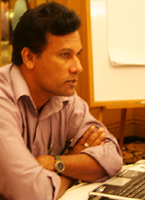| |
|
|

Interviews ::
 |
Amy Wu, an award-winning writer for the women’s Ag and Agtech movement |
 |
Ms. Irene Karani, Children’s Investment Fund Foundations’ Africa Climate Director |
 |
Natalia Schäfer (Schaefer), Leading and Globally Renowned Artist |
|
Read All Interviews |
News / Updates/ Analysis ::
COP 27- some hopes midst of chaos
Climate Change is Happening Now- Time to Take Action!
|


|
|
|

|
Hemantha Withanage founded Centre for Environmental Justice in 2004, a public interest environmental organisation based in Sri Lanka. Currently he is serving as the Executive Director’s position. He is a Steering Committee member of the Oil watch International. Hemantha Withanage has authored many environmental articles and publications. Hemantha has a long experience around the issues of climate change both at national and international levels.
Center for Environmental Justice is working towards environmental Justice and Good Governance. It provides free legal assistance for the public, engage in environmental education on climate change, Persistent organic pollution and development vs environment debate and environmental law education. CEJ leads many policy and legal advocacy including Genetically modified foods, Lead in Paint, heavy metal pollution etc.
|
- Your institution conducted a survey on Climate Change and its impacts in Sri Lanka. What was the major reason behind this study? What are the major issues captured in the study?
We believe that local communities should be the centre of any climate solution. They have the main role to play both in mitigation and adaption. However, while the negotiators address policy issues at the international level, there is no process for the local people who face the climate impacts to involve in such decisions.
This is a common scenario in every nation. In Sri Lanka, While Ministry of Environment engage in climate negotiations, it has appointed academics to produce the second communication under the Kyoto protocol. First communication was submitted in 2001. It has little or no communication with the communities affected by the negative impacts or even with the civil society organizations that engage in environmental issues.
Centre for environmental Justice (CEJ) initiated this research to bring the people’s voice to the climate discussion starting in October 2008.
- How do you level the public awareness, civil society engagement and government initiatives on different aspects of climate change?
People have a good understanding on the changed in the climate but some people mix the global climate issues with microclimatic changes. But they relate most natural disaster and weather pattern changes to the global climate change. See the charts below. Attached the copy of the report for more charts.
- Do you think capacity development on the issues of climate change is an important issue for Sri Lanka?
Although people understand the climate impacts, people, academics as well as government officers do not aware of the various mechanisms proposed by different people and including financial modalities, mitigation techniques, transfer of technologies etc. Simplified information and communication is a major area that needs capacity building. In my understanding the climate mitigation and adaptation knowledge should be given from school level to the informal education sectors.
- From the study what are the major climate change impacts noted by the public? What are the major challenges?
Climate change is visible in most parts of Sri Lanka. Majority people believe this climate change is unfavorable to living being and livelihood.
However, local climate changes in certain areas are better compare to 30 years ago or so.. For example Mahaweli water feeding areas in the dry zone gets more water are more favorable to people and the environment. However, local people cannot distinguish these local climate changes from the global climate change.
These unfavorable conditions are varying from community to community. Most nature dependent livelihoods such as farming, fishing, different types of labor, natural resources based sustainable livelihoods have negative impacts.
These communities have very very negligible contribution to the GHG emissions except the farmers engaged in slash and burn cultivation or animal husbandry. So they have nothing to mitigate.
However, above survey result shows that people mostly who engage in nature based livelihood are already suffering from climate change. They need alternative livelihood and living conditions. This means they have to adapt to the climate change.
Following are some of the notable findings obtained from the respondents that realized a change in climate.
- In Nuwara Eliya, the mist has reduced and the cold also reduced. Earlier heavy mist was experienced in November and December and recently the mist is reduced and it shifts to January and early February.
- People used to wear sweaters even in the day time in the past but presently the nights are also hot.
- There is a remarkable change in insect population. Increase in mosquitoes and flies is experienced in most of the areas. This is more significant in Nuwara Eliya as very few mosquitoes were distributed during the past, at present it has increased considerably.
- During the windy season the speed of the winds has increased and the pattern also changed.
- The temperature of the water in streams and rivers in Nuware Eliya has increased earlier it was too cold and difficult to drink.
- In Hakgala gardens, the size of the flowers has been reduced and the colours have changed.
- Frost is a rare occurrence nowadays in Nuwara Eliya.
- Snakes were abundant in Nuwara Eliya within the past few decades.
- Avocado, Anoda and Jack trees did not grow well in Nuwara Eliya, but now they grow and fruits are also well produced.
- During the past Banana and Capsicum plants did not produce pods due to the cold climate, but at present they bear fruits and pods.
- Several species of ferns and Orchids have been reduced heavily in Nuwara Eliya.
- The size of Apples and Pears have become smaller. According to the respondents ‘there were Pears that were the size of husked coconuts’.
- The increase of mosquitoes and house flies has been experienced in other parts of the country.
- August is considered as a dry month of the year, but it has changed as several rains fall in August.
- The dryness has increased and the wetness has been decreased.
- ‘Ilmaha wessa’,(Rain) the rain season during November has altered.
- Mist has been reduced in Ratnapura area.
Adaptation is a need of changes for the survival of the living beings in order to respond to the natural changes. This is part of the natural evolution too. However, sudden natural changes due to climatic impacts are crucial to the other living being except humans.
As we were going though the survey we found following areas need adaptation.
- The farmers have to adapt to the increased intensity of floods and the dry seasons. Change of the rain pattern has negatively affected farmers especially farmers engage in slash and burn cultivation. This may need moving the cultivation seasons or change of crops and cropping pattern. It may also need to find plant varieties that suit to the changing rainfall pattern.
- People living in the low line areas need to adapt to the increased level of flooding. Coastal low line areas face salt water intrusion which destroy the traditional livestock, grace lands, and the water table.
- Some water intakes are vulnerable to sea water ingression. This affects water facilities including Kaduwela water intake.
- As the ground water table is going down in certain areas, the water scarcity is becoming a major problem.
- Fisher folk face loss of coastal houses due to see level rise or at least due to heavy erosion by increased size of waves. They also have to face the loss of fish caused due to the acidification, coral degradation or dead zones and other unknown reasons.
- People in general have to adapt to the mosquito menace as its increasing in the areas that was considered as more colder.
- The earth slides have increased in some wet areas due to high rainfall over an extended period. People living in slopes and earth slide prawn areas need actions.
- Some houses may need stronger roof to adapt to the increased intensity of winds. Perhaps older structures are more vulnerable. Certain location might not suitable anymore for house constructions.
While some adaptations are part of the learning curve of the local people who has specialized on their locations, some adaptations need authorize proper but careful and cautious intervention.
As many people engage in environment related livelihoods are loosing the jobs it needs creation of green jobs in the future.
The result shows that climate change is not only a business of the environmental agencies of the government. It needs to be a crosscutting issue for many other authorities including Agriculture, water and irrigation, fisheries, meteorological, coastal, disaster mitigation and academics. The research team felt that even the provincial and local authorities have a role to play.
Local communities have lot to contribute to the climate plans. Keeping them out of climate business will create unnecessary damage to the life and livelihood. Bringing them to the climate planning will allow them to understand and contribute to the mitigation and adaptation. Therefore, democratizing of climate plans and actions should be done without further delay.
- In the context of climate change how do you see the future of tea, coconut, agriculture, and fishery sector which has been a key aspect of livelihood of many Sri Lankan? Who will be the major victims of these consequences?
Sri Lanka still has an agriculture based economy. Climate crisis will bring major problems to Tea, rubber and coconut and also paddy cultivation. The report shows that the increase of temperature in the Tea growing area which is in Nuwar Eliya district will have impacts on the quality of up country tea. Incease of floods already create destroy of the harvest in the paddy and they have to move into traditional varities rather than cultivationg newly introduced varities during the green revolution. It was found some verities such as “Hatada wee” is more resistant to dry seasons.
In this case mostly people engage in nature based livelihoods that are farmers, and the tea smallholders will be affected. Undoubtedly fishermen will be affected due to sea level rise and natural disasters.
- What are the major policy gaps in the context of climate change and its impacts in Sri Lanka?
In my opinion the policies on agriculture, trade, environment and conservation, coastal conservation and fisheries sector, Tea rubber and Coconut based economic policies need to be adjusted to the climate consequence. The forest sector policies need to reconsider in order to use them for community adaptation and as a source of mitigations. River and running water and the catchments need to consider for more water conservation. The infrastructure needs climate proofing. Canal systems and drainage need rehabilitation over the time to receive more flood water. Addressing climate refugees, disaster management need major policy changes.
- Any other thing you want to add?
The elected government will soon fail to address the climate disasters unless they have a major plan and implementation well ahead. Even the US was failed to face Hurricane Kathrina. Myanmar, Bangladesh all failed during Cyclone Nargiz and Sidr. Whatever the mojor political dialogues happen at the international level it will not eliminate climate crisis over night. Let the local people be ready for adaptation. Governments need a mechanism to bring them to the centre of climate solutions.
Date: 2010-03-23.
For your feedback: secretariat@earthconcernasia.com
Note: Opinions expressed in interview sections and individual write ups are of interviewee/ authors; earth concern facilitates to bring ideas and perspectives.
|
|

